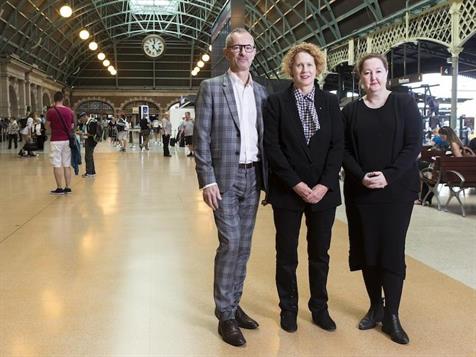Image CC Shutterstock
This month the Bayanihan Philippine Art Project will be presented across five Sydney city and metropolitan venues, each exhibition individually curated but marketed under a single banner.
Earlier in the year (March-May), we welcomed the inaugural edition of The National: New Australian Art, a biennial style exhibition across three of Sydney’s major arts organisations, steered by a jointly formed curatorium.
And completing the trifecta in curatorial collaborations, Destination Sydney bought together three, second-tier metropolitan galleries in a shared narrative to bolster clout, trailblazing the idea back in 2015. Again, each show took its own curatorial direction but were packaged together to increase visibility and promote foot traffic.
Read more on the Bayanihan Philippine Art Project: Does predictability make a good exhibition?

What we appear to be witnessing is a new model within curatorial circles that attempts to better utilise resources between organisations – not just by partnering from a branding perspective, aka the traditional “cultural tourism trail” and shared advertising, but by shaping a shared curatorial vision.
This is not easy to do within a competitive environment where future programming is as guarded as hidden treasures. Traditionally, galleries and museums have welcomed partnering but have held their curatorial IP as sacred.
Katrina Cashman, Curator at Mosman Art Gallery (MAG) told ArtsHub: ‘This approach offers so much more than notions of simply sharing costs or marketing resources. It’s a meaningful opportunity, and offers a “testing ground” amongst trusted colleagues for curatorial ideas to incubate.’
MAG will be hosting a forthcoming seminar on the topic, which describes: ‘The model of art galleries and museums working collaboratively on innovative curatorial projects is the currency of our age.’
It continues: ‘Increasingly there is an expectation from funding bodies for institutions to develop successful partnerships and curatorial projects to support their programs.’
Director Mosman Art Gallery, John Cheeseman added: ‘Thinking collaboratively is thinking bigger and smarter, and is a clear sign that participating institutions are curatorially ambitious, innovative and open to ideas. I believe there are substantial opportunities for galleries and museums to engage in a greater range of collaborations that could range from regional groupings of institutions, to national and international partnerships of scale.’
The seminar, titled Collaborations and Partnerships – Towards new curatorial models and modes of working, will look at four case studies and will be held on 1 September.
‘One lesson from these case studies is that there is no standard way for institutions to collaborate – each project has taken a bespoke approach,’ Cheeseman added.
So it is really a new idea?
Collaboration is hardly a new concept within the visual arts. Artists have been collaborating on making work for centuries, if we think back to Atelier studios.
The touring exhibition has long been the primary mode for connecting galleries, through the sharing of exhibitions across multiple audiences. Parallel to that, there has been a growing adoption of cultural tourism as a means of broadening audiences – that is, strategically looking beyond your plot to the neighbourhood to partner and package programming. It is a way of minimising – or parcelling – expenditure for a maximum result.
So what is new here?
There is arguably another model emerging. This is where a single exhibition is presented across multiple venues. In an odd way it has the framework of a biennale, but when applied to the regional and metropolitan gallery sector it becomes a powerful way of aggregating programming and audiences.
Destination Sydney, presented across Mosman Art Gallery, Manly Art Gallery & Museum and SH Ervin Gallery in December 2015 – February 2016, redefined the way exhibitions were conducted in Sydney, said Cheeseman.
He added: ‘The three participating venues created a temporary multi-venue institution that has the size, reach and breadth of vision to compete with any major gallery in Australia.’
Director of SH Ervin Gallery, Jane Watters added: ‘Destination Sydney as an exhibition would not have had the same impact had it only occurred in only one of the galleries.’

LtoR: Katrina Cashman (Mosman Art Gallery), Jane Watters (S.H. Ervin Gallery), Lou Klepac (independent curator), Katherine Roberts (Manly Art Gallery & Museum); Photo Adam Hollingworth, supplied
Expectation of funding bodies
Former ArtsHub journalist Madeleine Dore has described collaboration today as overrated – a ‘buzz word fashionable with grant agencies and lauded as creative dynamite’.
She writes: ‘There is a remarkable amount of emphasis placed on collaboration and its importance in the creative process and organisational growth. Perhaps it’s because it feels warm and fuzzy to include everybody in the process, like tales shared around a campfire. But is it really that good for creativity or are we just caught up in the hype?’
Read: Why collaboration is overrated
These recent projects appear to be proving that sentiment wrong, at least at an institutional level.
When The National: New Australian Art was announced in April 2016, project partner Director of the Art Gallery of NSW (AGNSW) Michael Brand said that the initiative was also about ‘building art sector sustainability’.

Michael Brand, Elizabeth Ann Macgregor and Lisa Havilah join forces to announce The National: they chose Central Station in Sydney to make the announcement to ensure neutrality and reinforce their joint platform; supplied
Cashman continued on the topic: ‘It’s probably not so much a question of “is there space within the sector to think about how we work collaboratively as institutions” but more a question of “can we afford not to think about how we work collaboratively as institutions”, as there does seem to be an increasing expectation from funding bodies for museums and galleries to work collaboratively.’
She added that in her experience many galleries are very open to working with other institutions, giving them the capacity to create curatorial projects that are essentially greater than the sum of their parts.
It is this kind of amplification and reach that funding bodies are looking for today.
The National, Destination Sydney and the Bayanihan Philippine Art Project all tick the box on that point. Indeed, it is only through such partnering that the breadth of the narrative approached by these projects is achieved; individually they would have been a flawed representation.
This is especially true of the Bayanihan Project, connecting the Art Gallery of NSW, Blacktown Arts Centre, Mosman Art Gallery, Peacock Gallery (Auburn) and Campbelltown Arts Centre in association with Museums & Galleries of NSW.
Cheeseman added: ‘Recently I was describing the collaborative elements of the Bayanihan Project to a well known national figure in the arts scene – they were surprised by it and replied that it did not sound like something that Sydney institutions would do. And that’s a key point – partnerships like these are quite an exception to the rule and provide a chance to establish new agendas and new paradigms for curatorial projects.’
Read more on Destination Sydney: Nightmare or boon – partnering across galleries
Read more on The National: Do we need The National?
Lessons learnt and key “walk-aways” for curatorial collaborations
Watters said Destination Sydney had a long lead time, and that it was the tone of the meetings across venues that lead to the success of the project.
Similarly, Director of the Museum of Contemporary Art Australia (MCA), Elizabeth Ann Macgregor said that discussions had been in play on The National with Carriageworks and the Art Gallery of New South Wales for a good 18 months prior to even the “announcement” of the project.
Watters continued: ‘Our meetings involved all partners to ensure that we shaped the vision for the exhibition collectively. Understanding each partner’s ability to contribute to the process and keeping in contact throughout the process is vital.
‘I think that working closely during the lead up also fostered better understanding of our stakeholders and audience, and having the ability to discuss all aspects of the projects with the other partners ensured a good outcome,’ she said.
The difference between The National and the other two projects is that it had a joint curatorium that steered the exhibition across the three venues. Choices were made collectively.
It was curated by Anneke Jaspers and Wayne Tunnicliffe (AGNSW); Lisa Havilah and Nina Miall (Carriageworks); and Blair French (MCA), and was the first-ever curatorial collaboration between these Sydney majors.
In the later case, curators from the individual organisations worked on their individual shows, but tapped into the collective narrative across the venues. Watters noted that, ‘collaboration needs commitment from all of the partners, so an understanding of each partners’ contribution / ability to contribute will ensure that a project will stays on track.’
There is no right or better model here. And as Cashman added, the process can be quite challenging, but can also be extremely inspiring. She offered the following points for embarking upon a curatorial collaboration:
Tips for curatorial collaboration:
- The selection of the curators you work with is of critical importance, it is just as important as the artist selection.
- A lack of passion spells death to the collaboration. People’s passions need to be focussed and directed.
- Collaboration is an interesting process as the goal is to work respectfully together towards an agreed common outcome, but the worst case scenario is that the work is led by consensus reached through compromise – of course some level of compromise is necessary but its really important that people are equally passionate and are on the same page about where that passion is directed.
- All ideas are on the table are up for discussion. Sit with them, consider them… then call it and weed them out!
- While there might be some overlap and repetition of task areas there are probably natural areas of skills sets or personal interests for people to pick up and run with, e.g. I enjoy writing and producing catalogues etc where as other curators run a mile from this kind of detailed work.
- Set the budget early, be realistic about it and try to get it confirmed from all parties involved. Otherwise you can have several options for exhibition development running concurrently for different budget expectations, which is tricky to manage.
The Collaborations and Partnerships symposium will be held at the Mosman Art Gallery on 1 September 2017. This is a ticketed event; booking details here. The event is presented by Regional and Public Galleries NSW, supported by Mosman Art Gallery and Museums and Galleries of NSW.





